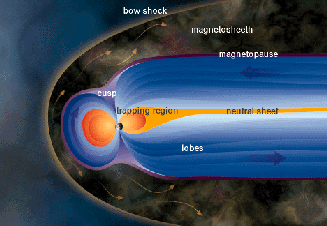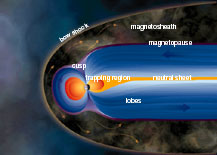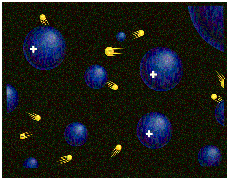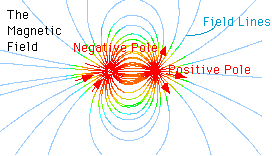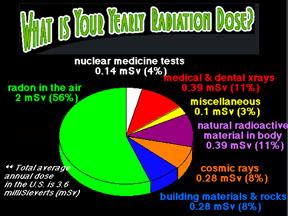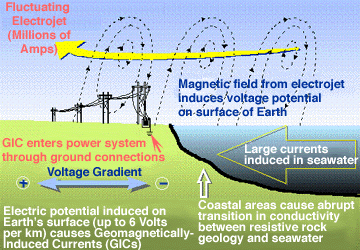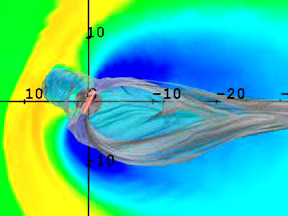Click on image for full size
Windows to the Universe original artwork.
Space Weather at Earth and in Near-Earth Space (Geospace)
Earth's global magnetic field generates a huge cavity or bubble in space, the magnetosphere, which shields our planet from most of the solar wind. Some solar wind particles do leak in and combine with ions escaping from the top of Earth's atmosphere to populate the magnetosphere with plasma. These energetic particles impact our lives as well - delighting us with beautiful auroral displays and bedeviling us by "zapping" electronics on satellites and "blacking out" electrical power systems on the ground.
Circulating motions of molten, ionized metals in Earth's core generate a global magnetic field. Earth's magnetic field is roughly a dipole, as though a giant bar magnet ran through our planet. But the poles of this field wander over time, confusing compasses, and occasionally flip completely around, leaving records of past ages in magnetized seafloor rocks. We use magnetometers to study Earth's field in detail, noting the many smaller, local contributions to the global field that distinguish it from a pure, idealized dipole.
Earth's magnetic field gives rise to a cavity or "bubble" in the solar wind around our planet. That "bubble" is Earth's magnetosphere. Solar wind protons and electrons mix with ionized gases leaked from the top of Earth's atmosphere to form a complex "soup" of plasma within the magnetosphere. The force of the IMF and Earth's magnetic field on these charged particles pushes the particles about, generating various electrical currents within the plasmas and accelerating some particles to high energies.
The uppermost, tenuous reaches of Earth's atmosphere merge gradually into space and thus the lower portions of the magnetosphere. Gases high in the atmosphere absorb most of the harshest forms of radiation from space, including energetic x-rays and ultraviolet photons, protecting us surface-dwellers from much of the radiation's threat. Absorption of energetic radiation drives the chemical reactions that control the makeup of our atmosphere. Accelerated, ionized gases escape the atmosphere into space, while solar wind particles "precipitate" onto the upper atmosphere from the magnetosphere. Space weather fluctuations alter the height and composition of the layers of the ionosphere, change the overall size of the atmosphere, and fill polar skies with breathtaking aurora.
What affect does space weather have on human society? Radiation can damage electronics on satellites and pose health risks to astronauts and even airline passengers and crew on trans-polar flights. Electrical and magnetic disturbances generated by space weather disrupt radio communications, cause electrical power blackouts, diminish accuracy of Global Positioning Systems (GPS), and interfere with magnetic prospecting. However, our atmosphere does protect us from most of the dangers posed by numerous types of radiation from space, and sometimes even treats us to a wonderful show in the form of the aurora (Northern or Southern Lights).


